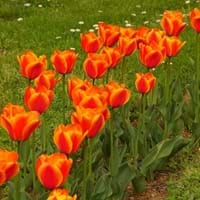Life Span
Perennial
Annual
Type
Perennial
Bulb or Corm or Tuber
Origin
World, Pandemic, North America, Europe, Africa, Asia
Hybrid origin, Europe, Turkey, Iraq, Iran, Asia, China
Types
Alizes
Bumblebee Deelite
Maui Moonlight
Langport Wren
Sarah Taylor
Titan's Glory
Thornbird
Jane Phillips
Orinoco Flow
Parrot Tulips, Triumph Tulips, Darwin Hybrid Tulips
Habitat
gardens, Hillside, Riverbanks, Warmer regions, Wet forest
Mountains, Temperate Regions
USDA Hardiness Zone
Not Available
4-8
Sunset Zone
Not Available
21,22
Habit
Clump-Forming
Clump-Forming
Minimum Height
Not Available
Minimum Width
Not Available
Flower Color
White, Yellow, Blue, Purple, Orange, Pink, Rose, Coral, Peach, Burgundy, Lavender, Plum, Orange Red, Dark Salmon, Bronze, Chocolate, Black
White, Yellow, Red, Green, Purple, Orange, Pink, Rose, Coral, Peach, Burgundy, Plum, Bronze
Flower Color Modifier
Bicolor
Bicolor
Fruit Color
Not Available
Green, Tan
Leaf Color in Spring
Not Available
Green
Leaf Color in Summer
Not Available
Light Green
Leaf Color in Fall
Not Available
Several shades of Green
Leaf Color in Winter
Light Green
Light Green
Leaf Shape
Long Linear
Oblong
Plant Season
Not Available
Spring
Sunlight
Full Sun, Partial Sun
Full Sun, Partial Sun
Type of Soil
Clay, Loam, Sand
Loam, Sand
The pH of Soil
Acidic, Neutral, Alkaline
Neutral
Soil Drainage
Well drained
Well drained
Bloom Time
Not Available
Early Spring, Spring, Late Spring
Tolerances
Drought
Drought, Shade areas
Where to Plant?
Ground, Pot
Ground, Pot
How to Plant?
From Rhizomes, Stem Planting
From bulbs, Seedlings
Plant Maintenance
Medium
Medium
Watering Requirements
Does not require lot of watering, Keep ground moist, Water when soil is dry
Do not water frequently, Does not require lot of watering
In Summer
Lots of watering
Not so frequently
In Spring
Moderate
Moderate
In Winter
Average Water
Average Water
Soil pH
Acidic, Neutral, Alkaline
Neutral
Soil Type
Clay, Loam, Sand
Loam, Sand
Soil Drainage Capacity
Well drained
Well drained
Sun Exposure
Full Sun, Partial Sun
Full Sun, Partial Sun
Pruning
Remove dead leaves, Remove dead or diseased plant parts, Requires very little pruning
Cut leaves after fall, Remove damaged leaves, Remove dead branches, Remove dead leaves
Fertilizers
All-Purpose Liquid Fertilizer
9-9-6
Pests and Diseases
Bacterial Diseases, Fungal Diseases, Viruses
Aphids, Gray mold, Nematodes, Red blotch, Snails
Plant Tolerance
Drought
Drought, Shade areas
Flower Petal Number
Single
Single, Double, Semi-Double
Foliage Texture
Medium
Medium
Foliage Sheen
Matte
Matte
Attracts
Bees, Butterflies
Aphids, Caterpillar, Mites, Rodents, Squirrels
Allergy
Asthma
contact allergic dermatitis
Aesthetic Uses
Beautification, Showy Purposes
Beautification, Bouquets, Cottage Garden, Showy Purposes
Beauty Benefits
Not Available
Not Available
Environmental Uses
Air purification
Air purification
Medicinal Uses
No Medicinal Use
Skin Disorders, Skin irritation
Part of Plant Used
Flowers, Leaves, Rhizomes, Root
Flowers
Other Uses
Making Perfumes, Oil is used for aromatherapy, Used as a sedative, Used as essential oil
Showy Purposes, Used As Food, Used as Ornamental plant, Used for its medicinal properties
Used As Indoor Plant
No
Sometimes
Used As Outdoor Plant
Yes
Yes
Garden Design
Bedding Plant, Cutflower, Mixed Border, Rock Garden, Wall
Bedding Plant, Container, Cutflower, Edging, Feature Plant, Foundation, Mixed Border, Rock Garden / Wall
Botanical Name
IRIS
TULIPA
In Portuguese
Íris
Tulipa
Phylum
Tracheophyta
Magnoliophyta
Class
Liliopsida
Magnoliopsida
Order
Asparagales
Liliales
Family
Iridaceae
Liliaceae
Clade
Angiosperms, Monocots
Angiosperms, Monocots
Tribe
Irideae
Not Available
Subfamily
Iridoideae
Lilioideae
Importance of Iris and Tulip
Want to have the most appropriate plant for your garden? You might want to know the importance of Iris and Tulip. Basically, these two plants vary in many aspects. Compare Iris and Tulip as they differ in many characteristics such as their life, care, benefits, facts, etc. Every gardener must at least have the slightest clue about the plants he wants to plant in his garden. Compare their benefits, which differ in many ways like facts and uses. The medicinal use of Iris is No Medicinal Use whereas of Tulip is Skin Disorders and Skin irritation. Iris has beauty benefits as follows: Not Available while Tulip has beauty benefits as follows: Not Available.
Compare Facts of Iris vs Tulip
How to choose the best garden plant for your garden depending upon its facts? Here garden plant comparison will help you to solve this query. Compare the facts of Iris vs Tulip and know which one to choose. As garden plants have benefits and other uses, allergy is also a major drawback of plants for some people. Allergic reactions of Iris are Asthma whereas of Tulip have contact allergic dermatitis respectively. Having a fruit bearing plant in your garden can be a plus point of your garden. Iris has no showy fruits and Tulip has no showy fruits. Also Iris is flowering and Tulip is not flowering . You can compare Iris and Tulip facts and facts of other plants too.





